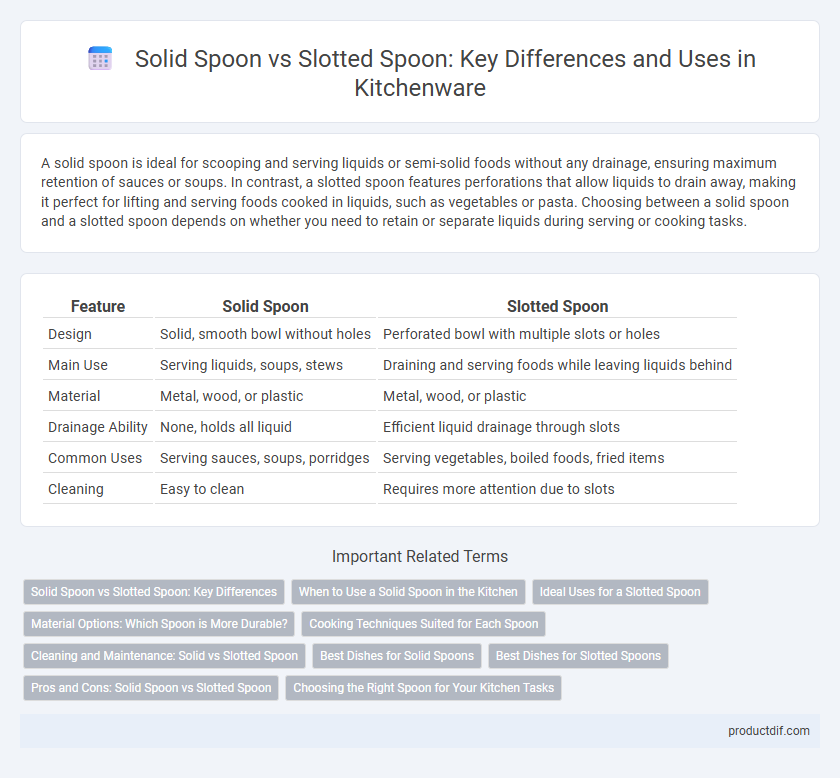A solid spoon is ideal for scooping and serving liquids or semi-solid foods without any drainage, ensuring maximum retention of sauces or soups. In contrast, a slotted spoon features perforations that allow liquids to drain away, making it perfect for lifting and serving foods cooked in liquids, such as vegetables or pasta. Choosing between a solid spoon and a slotted spoon depends on whether you need to retain or separate liquids during serving or cooking tasks.
Table of Comparison
| Feature | Solid Spoon | Slotted Spoon |
|---|---|---|
| Design | Solid, smooth bowl without holes | Perforated bowl with multiple slots or holes |
| Main Use | Serving liquids, soups, stews | Draining and serving foods while leaving liquids behind |
| Material | Metal, wood, or plastic | Metal, wood, or plastic |
| Drainage Ability | None, holds all liquid | Efficient liquid drainage through slots |
| Common Uses | Serving sauces, soups, porridges | Serving vegetables, boiled foods, fried items |
| Cleaning | Easy to clean | Requires more attention due to slots |
Solid Spoon vs Slotted Spoon: Key Differences
Solid spoons have a fully flat or slightly concave surface, ideal for stirring, serving, and scooping liquids or semi-solids without draining excess liquid. Slotted spoons feature perforations or slots, allowing liquids or fats to drain while lifting solid food, making them perfect for tasks like removing vegetables from boiling water. The choice between solid and slotted spoons depends on whether the goal is to retain or separate liquids during cooking and serving.
When to Use a Solid Spoon in the Kitchen
A solid spoon is ideal for stirring, serving, and transferring liquids or semi-liquid foods such as soups, stews, and sauces because its continuous surface holds liquids effectively. Use a solid spoon when you need to scoop and deliver food without draining away any liquid, preserving flavor and moisture in dishes. It is essential for tasks that require precision in handling liquids or thick mixtures, ensuring efficient meal preparation and serving.
Ideal Uses for a Slotted Spoon
A slotted spoon is ideal for lifting and draining foods from liquids, making it perfect for tasks like retrieving boiled vegetables, frying items, or skimming foam from soups and broths. Its perforated design allows excess water, oil, or sauce to drain away efficiently, preserving the texture and flavor of delicate foods. Chefs and home cooks often use slotted spoons when serving poached eggs, steamed vegetables, or canned goods to ensure minimal liquid transfer.
Material Options: Which Spoon is More Durable?
Solid spoons and slotted spoons are commonly made from stainless steel, silicone, bamboo, or plastic, with stainless steel offering the highest durability due to its resistance to rust and heat. Silicone spoons are heat-resistant and flexible but may degrade faster than metal options, while bamboo and plastic are less durable and prone to wear over time. For long-lasting kitchen tools, stainless steel solid and slotted spoons provide superior strength and longevity compared to their silicone or wooden counterparts.
Cooking Techniques Suited for Each Spoon
Solid spoons excel in stirring, serving soups, sauces, and thick mixtures where retaining liquid is essential, ensuring efficient mixing and portion control. Slotted spoons are ideal for lifting and draining foods from liquids, such as vegetables, pasta, or fried items, allowing excess liquid or oil to drain away. Each spoon enhances specific cooking techniques by combining functionality with precision in handling different food textures and consistencies.
Cleaning and Maintenance: Solid vs Slotted Spoon
Solid spoons offer simpler cleaning and maintenance due to their smooth, uninterrupted surface, which prevents food particles from getting trapped. Slotted spoons require more thorough cleaning to remove residue lodged in the slots, often necessitating a brush to reach narrow gaps. Both types benefit from dishwasher-safe materials like stainless steel or silicone, but solid spoons generally save time and effort during cleaning.
Best Dishes for Solid Spoons
Solid spoons are ideal for serving dense, liquid-rich dishes such as soups, stews, and sauces where retaining maximum liquid is essential. Their non-perforated design makes them perfect for scooping mashed potatoes, casseroles, and other thick-textured foods without losing any portion. Kitchenware experts recommend solid spoons for dishes requiring smooth, even portions and efficient liquid transfer.
Best Dishes for Slotted Spoons
Slotted spoons excel in draining liquids while serving, making them ideal for dishes like pasta, poached eggs, and steamed vegetables. Their perforated design allows excess water or oil to drip back into the pot or pan, preserving texture and flavor. This makes slotted spoons a perfect choice for lifting food items from broths, frying oil, or boiling water without carrying unwanted liquid.
Pros and Cons: Solid Spoon vs Slotted Spoon
Solid spoons excel at serving and stirring thick or liquid dishes, offering durability and efficient scooping without draining liquids. Slotted spoons are ideal for lifting foods out of liquids or fats, allowing excess liquid to drain quickly, which makes them perfect for frying or boiling tasks. However, solid spoons may trap unwanted liquid, while slotted spoons can struggle with small or thin ingredients due to their gaps.
Choosing the Right Spoon for Your Kitchen Tasks
Solid spoons are ideal for stirring, serving, and transferring liquids or semi-solid foods without any drainage, making them perfect for soups and sauces. Slotted spoons feature perforations that allow liquids to drain while lifting food, which is beneficial for tasks like retrieving vegetables from boiling water or skimming fat from broths. Choosing the right spoon depends on whether you need to retain or drain liquids during food preparation, ensuring efficiency and precision in your kitchen tasks.
Solid Spoon vs Slotted Spoon Infographic

 productdif.com
productdif.com